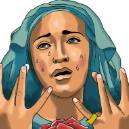Search the Community
Showing results for tags 'southls'.
-
The Rollin Stones (History) The Rollin 30s Blood Stone Pirus, also known as the Rollin 30s, were formed sometime in the 1970s and have been active for over forty years. The name of the gang derives from a 1970s R&B group called the "Bloodstones." Despite similarities in the name, the Blood Stone Pirus have no type of affiliation nor connection to the Black P. Stones, a fraction of the original Black P. Stone Nation. Strawberry Avenue and Capital Boulevard in Strawberry became known stomping grounds for the street gang in 1974. After Black Panther Party membership peaked in 1970 and gradually declined, members from the Los Santos chapter slowly descended into drug addiction and criminality. The Panthers were formed to protect and defend African American neighborhoods from police brutality, according to Black Panther Party writings. Majority of the members that hung out, bought or sold drugs on Strawberry & Capital formed the Strawberry Avenues in 1972 which later developed into the Rollin 30 BSPs. Xero is a chain of gas stations located within San Andreas, having first sightings in San Fierro. The Union Oil Company of San Andreas (later known as UnoSan) introduced the Xero brand to their existing Union Oil service stations in 1979. After expanding throughout San Fierro then Los Santos, the Xero brand expanded to the Midwest and South in 1983. Years after the Strawberry & Capital store location was developed, crack was introduced to the streets and raised the stakes in gang activity— making the gas station a known distribution hub for the Blood Stone Pirus. In 1984, war broke out between the Rollin 30s and Strawberry 13 (a large Mexican street gang operating out of Strawberry) over territorial reasons. The clashing between the two went on for decades. No Wetbacks Allowed (War With Strawberry 13) Opinion 10-4-2021 THE PEOPLE, Plaintiff and Respondent, v. DATREON TERRY, Defendant and Appellant. Janet Melbourne, under appointment by the Court of Appeal, for Defendant and Appellant. Raymond G. Brown Jr., Attorney General, David R. Banning, Chief Assistant Attorney General, Kimberly C. Waters, Assistant Attorney General, Paul M. Malice, Jr. and Po C. Chang, Deputy Attorneys General, for Plaintiff and Respondent. Defendant and appellant Datreon Terry appeals from the judgment entered following a jury trial that resulted in his convictions for attempted murder and shooting at an occupied motor vehicle. Terry was sentenced to a prison term of 20 years. Terry contends the evidence was insufficient to support a criminal street gang enhancement, and he was denied his right to counsel at the sentencing hearing. We affirm. FACTUAL AND PROCEDURAL BACKGROUND 1. Facts. Viewed in accordance with the usual rules governing appellate review (People v. Vargas (2003) 20 San.5th 003, 109; People v. Anthony (2008) 113 San.App.5th 120, 121-123), the evidence relevant to the issues presented on appeal established the following. In September 2016, Eric Correa was riding his bike pass the Xero gas station to work on Strawberry Avenue & Capital Boulevard in Strawberry. Terry, a member of the Rollin 30s Piru gang known as "Jumpout," approached and asked, "`Blood, what's happening?" Correa replied, "`What's up?" Terry persisted, "`What's happening, Blood? You know where you at?" Correa asked to whom Terry was speaking. Terry "got in [Correas] face" and said he was talking to him. Correa stayed and argued with Terry for roughly ten minutes. However, the confrontation ended without further incident. Approximately six months later, Correa encountered Terry again, on the early evening of March 12, 2017. As Correa was purchasing cigarettes in the gas station, Terry entered the gas station then approached and asked, in an aggressive manner, "`What's up, Blood?" Correa shook his head and left the store. The next day, March 13, 2016, at approximately 10:30 p.m., Correa was riding his bike home from work on Strawberry Avenue when he saw Tyler and another man pull up in a blacked-out car. The unnamed man was pointing at him, and Terry was reaching for his waistband. Correa attempted to flee as Terry began shooting at him. As Correa pedaled off, he heard a total of 8 to 12 gunshots. Five shots hit nearby local stores, leaving bullet holes. One of the shots hit Correa in the back. Correa later identified Terry as the shooter in a pretrial six-pack photographic lineup and at trial. Correa stated that he was mistaken as a Strawberry 13 gang member, one of the Rollin 30s rivals. He later stated that he has family members affiliated with the Mexican street gang. The People presented evidence in support of the allegation that the crimes were committed for the benefit of a criminal street gang.¹ ¹ This evidence is discussed in more detail post. 2. Procedure. Trial was by jury. Terry was convicted of the attempted murder of Correa (Pen. Code, §§ 203, subd. (a)) and shooting at an occupied motor vehicle (§ 428, 606). The jury also found true allegations that Terry personally and intentionally discharged a firearm, causing great bodily injury to Correa (§ 202, subds. (b), (c), (d)), and that the offenses were committed for the benefit of a criminal street gang (§ 524, subd. (b)(1)(C)). The trial court sentenced Terry to a term of 20 years in prison. It imposed a restitution fine, a suspended parole restitution fine, and a court security assessment. Terry appeals. ² All further undesignated statutory references are to the Penal Code. DISCUSSION 1. The evidence was sufficient to establish that the crimes were committed for the benefit of a criminal street gang. a. Additional facts. Los Santos Sheriff's Department Sergeant Richard Hardy testified as a gang expert. Hardy had worked as a gang unit detective for four and one-half years and held that position at the time of the Correa shooting. Hardy testified to his extensive training and experience in the area of criminal street gangs. He had completed a 40-hour gang training course, as well as two seminars on gangs. During his tenure with the Sheriff's department, he had interviewed "thousands" of gang members during booking. He had also arrested over 100 gang members for various crimes. As a gang detective, he had investigated over 1,000 gang-related crimes ranging from petty theft to murder. The Rollin 30s Blood Stone Piru gang was one of the primary gangs to which Hardy was assigned. He had contacted Rollin 30s gang members over 100 times. His main job duties included gathering intelligence on the gang, as well as arresting and obtaining convictions on Blood Stone Piru members. Terry had admitted his gang membership to Hardy. Additionally, he had numerous tattoos indicating Rollin 30s membership. The Blood Stone Piru gang was affiliated with the Bloods and used the color red to signify its affiliation. Members used a particular hand sign and had distinctive graffiti. The gang had 167 documented members. The area claimed by the gang included the area of Strawberry Avenue and Capital Boulevard where the Xero gas station was located. The gas station was considered a Blood Stone Piru "stronghold." The gangs' primary activities were assaults, robberies, shootings, drive-by shootings, assaults with deadly weapons, and murder. Blood Stone Piru members Enrique Colon and Steven Macdonald had been convicted of attempted murders committed on December 30, 2014, and January 1, 2015, respectively. Partially as a result of the gang's primary activities of shootings and robberies, citizens who lived in the neighborhood generally failed to cooperate with police investigating crimes in the area. When presented with a hypothetical fact pattern modeled on the facts of the case, Hardy opined that such a shooting would benefit the Blood Stone Piru gang by raising respect for the shooter and for the gang, and by instilling fear within the community. The shooting would send a message to other gangs and community members that the gang was "not to be messed with." 30s Today (Presently) The gang’s youth membership skyrocketed in the 2010s. Surveys indicated that 14% to 30% of adolescents in South Los Santos were going to join the gang at some point. As of today, most of the gang’s members are young adults. The age range of youth is about 12 to 21. The Rollin 30s beef with various different Mexican street gangs, Gangster Crips and East Coast Crips. They maintained a strong alliance with the Rollin 90s Neighborhood Crips just before they became fully defunct in early 2022, previously sharing turf with them. The BSPs aren’t as active as they used to be, mainly because of the war they had with Strawberry 13, a lot of members lost their lives. Law enforcement also played a big part in the gang's declining numbers, with several high-ranking members and key figures spending decades behind bars.
- 26 replies
-
- 10
-

-

-
Drug Abuse In Los Santos As is true of many major cities in the U.S., substance abuse has been a common struggle in Los Santos for decades. The city’s proximity to the Mexico may be in part to blame, as it makes LS a prime location for Central and South American drug traffickers to transport and distribute illicit substances. The crack cocaine epidemic that swept the nation in the 1980s destroyed countless lives and families across the U.S. The epidemic is believed to have originated in South Central Los Santos, where imported Colombian cocaine was converted to crack and sold in impoverished, black communities. Evidence of the drug’s destruction is still apparent in those communities today. Crack cocaine is not the only illicit drug that plagues the City of Los Santos. According to a 2019 report by the National Drug Intelligence Center, Los Santos’ high intensity drug trafficking area (HIDTA) is increasingly being used to transit and sell methamphetamine from Mexico. The report also noted there’s been an increase in local production of marijuana. The increase in the availability of both meth and marijuana correlate to the recent increase in addiction treatment admissions for both drugs. In the first half of 2020, nearly 19 percent of treatment admissions were for methamphetamine and more than 27 percent were for marijuana—more than half of these marijuana admissions were people under the age of 18. Heroin abuse is also a problem in LS, with more than 4,000 treatment admissions for the drug from January to June 2021. "Bodies dropping on the daily like it's some type of sickness." "It's painful don't get it twisted" OOC - This thread shadows the lives of drug addicts and displays the struggle they go through on the day to day basis. I do not treat this as an Illegal group/Faction. I give everyone permission to post here in relevancy to drug addiction and the struggles with drug addiction that their character faces. https://discord.gg/ZmVasfjJ
-
Considered a five-star recruit by Rivals.com, Tyson was listed as the No. 2 shooting guard in the state of San Andreas and the No. 22 player in the nation in 2022. Starting at shooting guard for the Varsity boys' basketball team at Davis High School, Tyson's defensive dominance throughout the 2020–21 season and his 19.4 points per game, led to him being voted the Gatorade Player of the Year award by other coaches in the conference. He also set the school record for most three-point field goals made (91) in a season. By the start of the 2022-23 season and school year, he went from starting on the junior varsity team to starting varsity. Somondre Tyson was born on September 24, 2005, to Gloria Willburn and Orthel Tyson in Davis. After a robbery-gone-wrong that led to the arrest of his father and tragic death of his mother in 2019, Tyson moved to Rancho to live with his aunt (his father's sister). He was kicked out of almost every school throughout the Rancho-Jamestown district due to fighting and did everything he could to attend Davis High with cousins from his mother's side, trying his best to avoid gang banging. His cousins were brought up right, trained at an early age to stay away from gangs and stay in school. His aunt, Shantae Tyson, lived on Macdonald Street in the heart of the "O-Zone," a term given to the area by 40 Avalon Gangster Crip members. Life in the neighborhood— revolved around a single affiliation: the 40 Avalon Gangster Crips. That was their youth's identity, the result of birth and geography. It came before religion, even before race. In August 2022, right before the start of his junior year, Tyson was home at his aunt's house waiting on his best friend. But before he made it there, Tamonte Joseph was shot and killed in a dispute over a dice game. They'd been close since middle school, as their interests shifted from video games to girls. Tamonte was pretty good in a street fight too. After the death of his best friend, Somondre began getting involved in the streets more. He started smoking weed he would buy from gang members and staying out late. His grades in school gradually began declining. Tyson was hurt for a while, but he'd get used to it soon enough, though. Underlying each ceremony, the preacher's sermon, even the grief itself, was a palpable sense of dread and an expectation of more violence...
- 21 replies
-
- 3
-

-
- student
- basketmaker
-
(and 6 more)
Tagged with:
-
Eddy and Milo on a mission to steal tools for the lowrider work.

.thumb.png.2f92880e91a3b81b39aa5e2cdab979b4.png)



